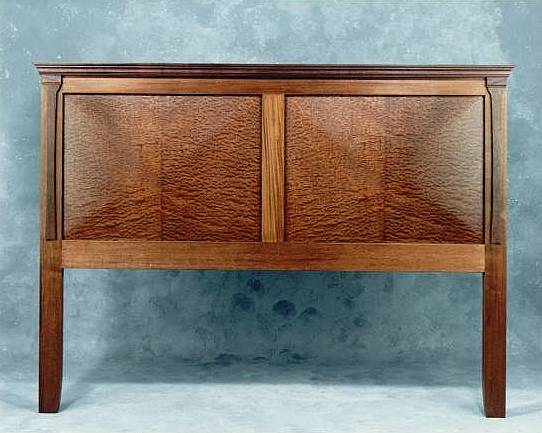
The key to good veneering, says Wayne Hoffman, is a good substrate. That’s the foundation for the longevity of the piece and, with modern materials, gives today’s woodworker a distinct advantage over woodworkers of the past.
Wayne works with both solids and veneers, but the veneers give him so much more choice and variety for his designs that he can’t resist the stuff. He uses MDF as a substrate unless there are weight issues. If he needs a lighter base, he will use plywood, but he doesn’t like it. “I’ve never seen a flat piece of plywood,” he says, and that messes up the precise work he gets hired to do.
Along with MDF, he swears by regular wood glue and never uses contact cement. He also avoids any veneer with any kind of backing, preferring raw veneer because he finds some of the best patterns in those pieces that haven’t been picked over by the manufacturer.
He built his own vacuum press for veneering and swears by it. He even teachesa course on vacuum pressing. While you don’t get the pressure that you would get with clamps and cauls — which is not much more than atmospheric pressure anyway, Wayne says — all of the pressure you do get with a vacuum press is distributed completely evenly across the piece.
Wayne has taken on some very odd veneering projects over time. Two recent projects took him a year apiece to accomplish. In one case, he was commissioned to veneer an entire office-walls, shelves, desk, ceiling, etc. The only thing he didn’t veneer was the floor. If that wasn’t tough enough, the client wanted the bird’s-eye veneer distinctly gray, and Wayne wasn’t sure how to do that. Eventually he found a company in Italy who specialized in this kind of thing. The trick was getting the original yellow tint out of the veneer, which they did with wood bleach, and then dying it the required gray.
They ended up shipping all the veneer overseas and then shipping it back. The second big project was a whole wall of a home theater, complete with double curved vaults, and all of it veneered.
Getting veneer to fit over some curves is tougher than others. In the raised veneer panels he has made, and with a job veneering the dashboard of a Mercedes, he had to literally stretch his luck with the veneers he was working with. “It’s very difficult to bend veneer in two directions,” Wayne says, but he’s developed a couple of tricks to help over the years. First off, once the veneer is glued down and in the vacuum press, the bag allows him to push and stretch the veneer ever so subtly. That’s how he got the veneer to fit on the raised panel.
The other thing he uses to help the veneer stretch is fabric softener, which he will rub into the veneer before he sets it down on the substrate. It often helps to get it wet with water right before you apply it, but that’s a lot trickier, with since you then need to worry about moisture.
Wayne started woodworking as a stay at home dad. He moved out to the mountains with his wife after a career as a political science professor and another as a computer geek. When they started a family, he volunteered to stay at home with the kids while his wife worked. He went to a local woodworking guild meeting, and the rest is history. He taught himself the craft as he took care of his kids. But, then, he needed a shop. They had moved into an old Victorian house in Oregon and it only had a half-basement. So one of his early projects was to jack the house up and dig a full basement for his shop.
When his craft started taking up more space, he bought a building with the idea of sharing the space with other woodworking professionals. That’s where he is now, sharing the building with other craftspeople he admires and collaborates with.
Though he works with a lot of varieties of veneer, he really prefers pomelle sapele. He also has some very special veneer that he only brings out for the right occasions. It’s Ceylonese rosewood, cut from a tree the year he was born, and he’s never seen anything like it since. He says it’s not flashy, but it contains the essence of all that makes wood beautiful.
– Bob Filipczak





